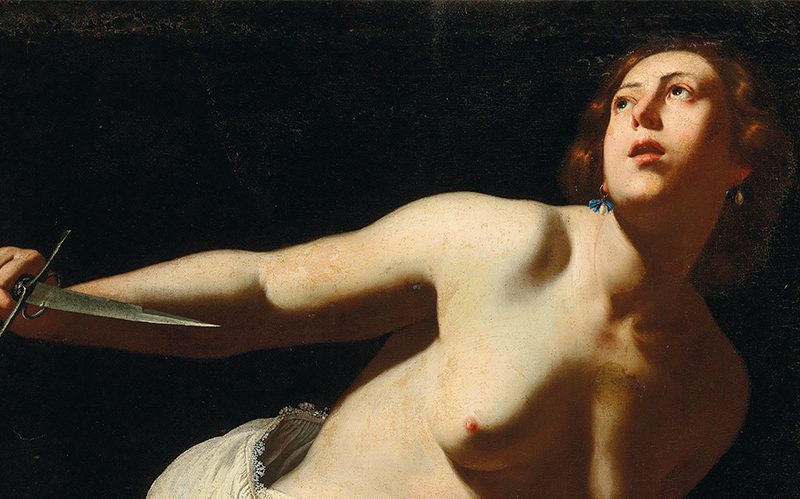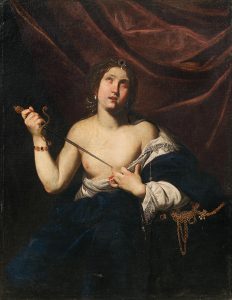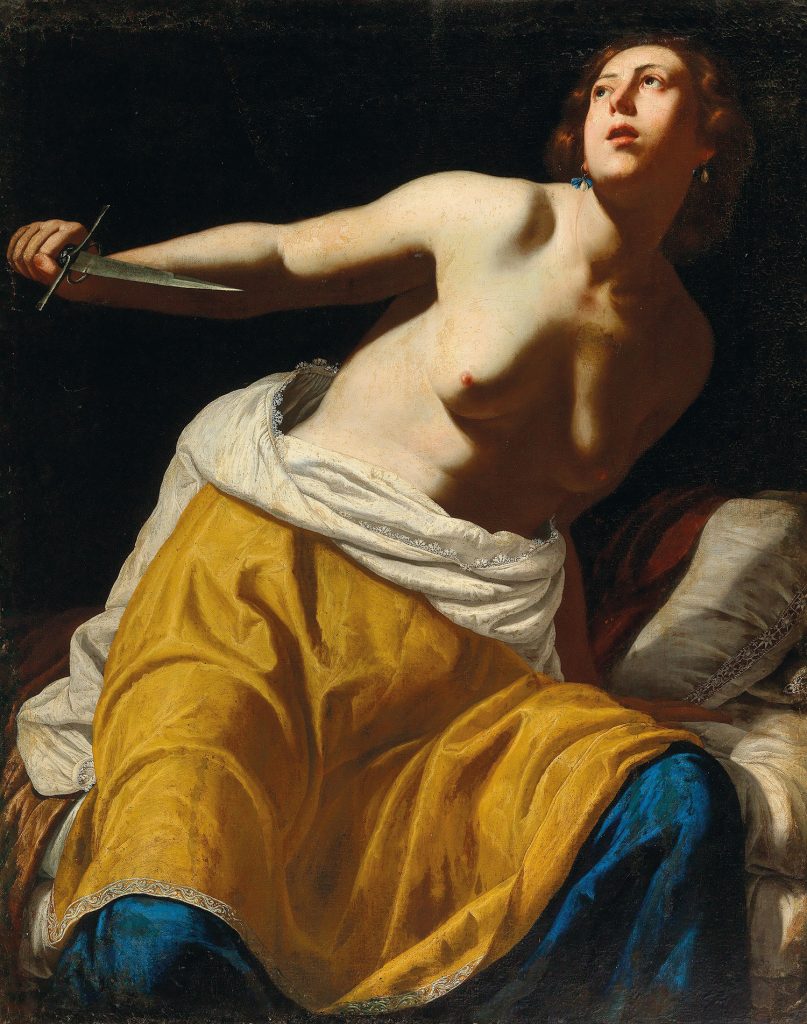
This is female power:
Three women, two women artists, two paintings of Lucretia.
Artemisia Gentileschi and Diana De Rosa prevailed against their male artist colleagues. One of their favourite motifs was brave Lucretia, a symbol of resistance against male violence.
Lucretia
Lucretia is the heroine who most fully represents absolute fidelity to honesty, beyond even love of family. Livy recounts how, by virtue of her goodness, Lucretia aroused the twisted desire of Sextus Tarquinius, who raped her. After suffering this violation under threat of death, she took her own life before her father and husband, asking only that they avenge her violator. In the 17th century Lucretia was an icon of another drama, albeit a positive one, owing to the exemplary value of her actions. For reasons that remain mysterious, two interpretations of the heroine belonged to the same ancient collection. Today, thanks to Dorotheum, they can once more be seen together. The first is by the finest female painter of 17th-century Naples, Diana De Rosa; the second is by her most renowned Italian colleague, Artemisia Gentileschi.
Diana De Rosa
We still know very little about Diana De Rosa, also known as Annella di Massimo, the sister of Pacecco De Rosa, beyond the fact that she was one of the very few women artists active in Naples and that she attained notable success in her profession. According to a bleak legend, Diana died by the hand of her own husband, the painter Agostino Beltrano, who was jealous of the close, though platonic, relation Diana entertained with Massimo Stanzione. Today, however, it is known that Diana died wealthy in 1643 aged 41, and that she was one of the foremost painters in the circle of Stanzione, the leading exponent of Neapolitan classicism.
Diana’s Lucretia

Lucretia
Öl auf Leinwand, 129 x 103 cm
€ 80.000 – 120.000
Indeed, her “Lucretia” now with Dorotheum reveals connections of style and composition with the “Cleopatra” by Stanzione in the Durazzo Pallavicini collection in Genoa, which also served as the source for Francesco Guarino’s “Saint Agatha” now held by the Museo Capodimonte in Naples. Diana’s artistic personality becomes evident in the magnificent handling of the open shirt over the subject’s breast, in the shimmering reflections of her deep blue robes, and in the undulating folds of the dark background drape. The Roman noble lady’s jewellery is resplendent on her wrist and in her hair; her inspired expression speaks of her determination to make the ultimate sacrifice. The point of her long dagger has already pierced her flesh and the words of her famous last phrase appear to issue from her lips: “It is up to you to establish what [Sextus Tarquinius] deserves. As for me, although I acquit myself of the blame, I am not freed from the penalty. And so, from this day on, no woman will live with dishonor and plead Lucretia’s example!”
Artemisia Gentileschi
Artemisia Gentileschi created her “Lucretia” only a few years earlier. The artist’s subject matter reflected her own life. As a young woman she suffered sexual abuse and, most unusually for her time, participated in the prosecution of her attacker. The spectacular trial in Rome damaged Artemisia’s reputation; she had to leave the city and went on to grind out a new career as a highly distinguished artist. Her “Lucretia” is a painting of extreme power, typical of her early Neapolitan years around 1630. The contrasting violence of the chiaroscuro in the splendour of the skin tones, with the white, yellow-gold and deep blue of the drapery, signals Artemisia’s fascination with the inventions of her Neapolitan mentor, none other than Massimo Stanzione.
Artemisia’s Lucretia

Lucretia
Öl auf Leinwand, 133 x 106 cm
€ 500.000 – 700.000
The viewer seems virtually able to reach out and grasp the vigorous form of Lucretia as she dynamically moves to the right edge of the pictorial stage. On Artemisia’s arrival in Naples, she worked under the protection of Stanzione, who served her as guide to the southern capital at the start of her sojourn and helped her obtain important patrons in the Spanish court. Her “Lucretia” introduced the Neapolitans to new motifs.
The diagonal composition of her rendering of the Roman noble lady’s pose can be compared to Simon Vouet’s “Lucretia” now in the National Gallery in Prague. Both Artemisia and Stanzione were friends with Vouet. By 1630 Stanzione had definitively gained the epithet of “Guido partenopeo”, as he was called in Naples owing to his stylistic affinities with the art of Guido Reni. Indeed, in the Neapolitan master’s “Lucretia”, now Capodimonte, we are witness to his fusion of Vouet’s late-caravaggist inventions of his Italian period with the classicism of Reni.
Inspiring Examples
The painting by Artemisia now with Dorotheum and that by Stanzione at Capodimonte share certain elements of composition, for example in the luxuriously aristocratic robes worn by the protagonist. It is no surprise, however, that a few years after Artemisia had created her “Lucretia”, perhaps around 1635/40, Stanzione made another, very similar version of the subject modelled on hers: it was made for the Durazzo Pallavicini collection in Genoa to serve as a pendant to his previously mentioned “Cleopatra”.
But where did the invention of this figure composition come from?
As is often the case with works of the Baroque age made in Rome, a source should be sought in antique sculpture. One of the most famous sculptural groups was the “Massacre of the Niobids” from the gardens of Villa Medici in Rome: this was a Roman copy of a Greek original; it was famous among Italian artists from the end of the Cinquecento and was moved to the Uffizi in Florence in 1770. Similarly, the “Chiaramonti Niobid” in the Vatican Museums, which was known in the 17th century thanks to numerous antique versions, also served as a compositional source for Artemisia’s “Lucretia”. These statues must have supplied Vouet, Reni, Artemisia and Stanzione with the idea of a figure dramatically inclined at an angle. One of the Niobids seeks in vain to shelter herself from the arrows of Apollo:
in the versions of “Lucretia” discussed here, this pose is applied to emphasise the Roman noble lady’s gesture. The use of antique models was unusual in Naples around 1630. On her arrival in the southern capital, Artemisia absorbed the lesson of Stanzione, but enriched it with Roman influences and her own potent personality. Then as now, to depict Lucretia meant to speak of violence against women as well as of victory over the violence suffered. No one more than Artemisia had just title to do so in ways that still today command our admiration for the potency of her painting.
AUCTION
Old Master Paintings
23 October 2018, 5 pm
Palais Dorotheum
Information:
Mark MacDonnell, specialist for Old Master Paintings
You want to find out more about the Old Master Paintings auction?
Browse the online catalogue or visit the Palais Dorotheum!













